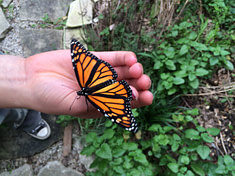Who created "permaculture"? Where did it start?
In this series of introduction to permaculture articles, I wanted to layout the basics. So here we are looking at the origin of permaculture. In the last one, I shared my definition of permaculture. There, I said it is "an ethical system of design that integrates humans with the natural world." There are hundreds of definitions of permaculture, and that makes it stronger.
Still, the system of design I refer to had a point of origin. Two brilliant and colorful characters, Bill Mollison and David Holmgren met when both were involved in university in Tasmania in 1972. Their months-long conversation critiquing industrial agriculture and the Green Revolution led them to the ideal of "permanent agriculture."
Their synthesis of observed indigenous wisdom and practice, systems thinking, and the new understandings of ecological science led to not only an understanding of the damage industrial agricultural systems were wreaking in a globalizing world, but the impact on culture and a process for undoing the damage. This design process is grounded in the three ethics (Care of the Earth, Care of People, and Care of the Future). The process also guides us to mimic the natural patterns found in any particular place. All culture begins in nature.
In practical terms, this means permaculture relies heavily on restoring perennial plant systems using new combinations of productive, high-yielding species. Tending landscapes using these strategies reinvigorates the systems indigenous humans created and tended around the world throughout our history as a species.
And, there was precedent in academic and scientific circles as well. J. Russell Smith had published a book on Tree Crops (1929) in the horticultural ferment of the 1920's, and Masanobu Fukuoka's One Straw Revolution (1975) was spreading about the same time that Permaculture One (1978) was published.

What came before permaculture?

As I mentioned, indigenous humans around the planet and throughout time created systems of tending the landscape. Some were more successful than others (three previous civilizations failed in China according to the archeological data). In fact, I've come to believe that any human dependent on the land they have access to and with enough resourcefulness time to experiment will come up with many of the strategies and techniques utilized in permaculture design. For example, weir systems harvesting from the tides are very similar between the Haida of the Pacific Northwest and those found on ancient British coasts.
From a more recent experience, my own grandfather developed gardens and systems in his many garden farms in the 1970s-90s. Despite his poverty and lack of education, he developed massive gardens at multiple sites that incorporated trees, shrubs, annual crops, hoop houses, poultry and rabbits. His plantings were on contour and used the light and microclimates to advantage. He used deep mulch to control weeds and keep pathways clear. He heated his home with scrap wood from the local sawmill, canned a massive amount of food. There was cold storage on a north-facing porch. Water was tucked away in gallon jugs, in case the well went dry. We foraged for nuts, mushrooms, wild medicines, and berries regularly.
There is a lot, looking back, that came from trial and error. His awareness of what was happening in his gardens (all five of them stretched over the county) was amazing. Frequently he would pause to show me some plant he'd imported and grown for the first time.
I am fairly certain he never heard of permaculture. A deeply conservative man, he likely wouldn't have been a Mother Earth News reader either. 🙂 That didn't stop him from being connected to the Earth and the cycles of creation and tending implied in permaculture.
Personally, I believe we all need to re-develop our relationship to the Earth (hence Touch the Earth), and to live in relationship to that Earth in a way that is mutually healing. In my journeys, I've connected with many others who share this perspective.
How did it spread?
Permaculture spread initially through publications. There was Permaculture One, then Permaculture Two, then The Designers Manual, then came the Introduction to Permaculture. By this point, Mollison had gone around the world planting the system among likely candidates.
The first international permaculture convergence (IPC) happened in the early 1980s. The IPC agreed to a standard curriculum for a permaculture design course by the mid-1980s. This meant permaculture people around the planet had a common foundation for sharing ideas. From there, permaculture courses and institutes have grown to bring an understanding and practice to hundreds of thousands of people.
In North America the first courses were in 1982 and 1983. Mollison essentially said, if you've taken the course go teach. Amazing projects came out of those initial courses. Slowly into the 1990's more teachers and teaching teams formed. By the time I took my own course in 2005, permaculture was still largely unheard of. North American permaculture has been weedy and wild. Still, more people are at least familiar with the term and have a sense of what permaculture is. More education is needed--and a lot more implementation.
From my perspective, the permaculture design course is an onramp for people from mainstream society to a better future. It's just the beginning of a cultural shift. There are other doorways to that shift, but permaculture design has a lot of tools in the toolbox. There is a great deal of potential for building bridges between people who experience the world in radically different ways, but find a common vision of where they want to go.
